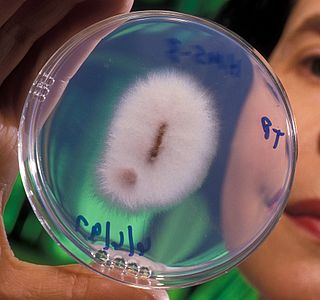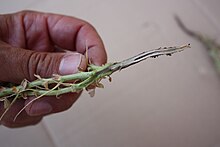
Fusarium oxysporumpronounce (help·info), an ascomycete fungus, comprises all the species, varieties and forms recognized by Wollenweber and Reinking within an infrageneric grouping called section Elegans. It is part of the family Nectriaceae.

Fusarium wilt is a common vascular wilt fungal disease, exhibiting symptoms similar to Verticillium wilt. This disease has been investigated extensively since the early years of this century. The pathogen that causes Fusarium wilt is Fusarium oxysporum. The species is further divided into formae speciales based on host plant.

Fusarium/fjuˈzɛəriəm/ (help·info) is a large genus of filamentous fungi, part of a group often referred to as hyphomycetes, widely distributed in soil and associated with plants. Most species are harmless saprobes, and are relatively abundant members of the soil microbial community. Some species produce mycotoxins in cereal crops that can affect human and animal health if they enter the food chain. The main toxins produced by these Fusarium species are fumonisins and trichothecenes. Despite most species apparently being harmless, some Fusarium species and subspecific groups are among the most important fungal pathogens of plants and animals.
Fungal keratitis is a fungal infection of the cornea, which can lead to blindness. It generally presents with a red, painful eye and blurred vision. There is also increased sensitivity to light, and excessive tears or discharge.

The wildlife of Ghana is composed of its biodiversity of flora and fauna.

Fusarium oxysporum f.sp. albedinis is a fungal plant pathogen that causes a disease known as Bayoud disease or fusarium wilt primarily on date palm.
Fusarium oxysporum f.sp. asparagi is a fungal plant pathogen infecting asparagus.
Fusarium oxysporum f.sp. batatas is a fungal plant pathogen infecting sweet potatoes.
Fusarium oxysporum f.sp. betae is a destructive fungal plant pathogen. It causes Fusarium yellows or fusarium wilt, characterized by yellowing and dwarfing.
Fusarium oxysporum f.sp. pisi is a fungal plant pathogen infecting peas, endemic to Moldova.
Fusarium oxysporum f.sp. radicis-lycopersici is a fungal plant pathogen.
Fusarium oxysporum f.sp. vasinfectum is a fungal plant pathogen.

Fusarium subglutinans is a fungal plant pathogen.

Fusarium solani is a species complex of at least 26 closely related filamentous fungi in the division Ascomycota, family Nectriaceae. It is the anamorph of Nectria haematococca. It is a common soil fungus and colonist of plant materials. Fusarium solani is implicated in plant disease as well as human disease notably infection of the cornea of the eye.

Fusarium oxysporum f.sp. lycopersici is a fungal plant pathogen. It is a big pathogen to the tomato plant. It has a violet to white color on most media but does not produce a pigment on King's B medium.

The enzyme cutinase is a member of the hydrolase family. It catalyzes the following reaction:

Fusarium oxysporum f. sp. cubensePronunciation (help·info) is a fungal plant pathogen that causes Panama disease of banana, also known as fusarium wilt of banana. The fungi and the related disease are responsible for widespread pressure on banana growing regions, destroying the economic viability of several commercially important banana varieties.

Microbial corneal infection is the most serious and "most common vision threatening" complication of contact lens wear, which is believed to be strongly associated with contact lens cases. Such infections "are being increasingly recognized as an important cause of morbidity and blindness" and "may even be life-threatening." While the cornea is believed to be the most common site for fungal eye infections, other parts of the eye such as the orbit, sclera, eyelids, and more may also be involved. Contact lens cases are recognized as a "potential source of pathogens associated with corneal ulcers" and according to Moorfields Eye Hospital, contact lens wear is “the most prevalent risk factor for new cases of corneal ulcers.” Contaminants "isolated from contact lens associated corneal ulcers have often been shown to be" the same as found in the patient's contact lens case, thus providing evidence contaminated contact lens cases may be a "replenishable source of pathogenic microbes."

Pisatin (3-hydroxy-7-methoxy-4′,5′-methylenedioxy-chromanocoumarane) is the major phytoalexin made by the pea plant Pisum sativum. It was the first phytoalexin to be purified and chemically identified. The molecular formula is C17H14O6.













